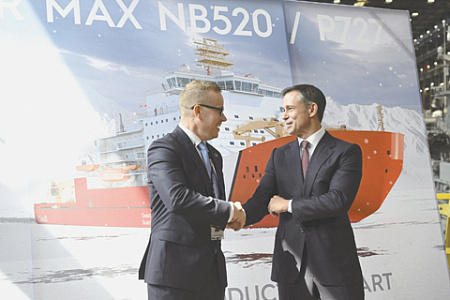
A new trilateral agreement between the United States, Canada, and Finland has entered its implementation phase, marking a significant strategic effort to counter Russia’s long-standing supremacy in the Arctic. The partnership, driven by geopolitical objectives, has officially commenced with the construction of the ‘Polar Max,’ a state-of-the-art icebreaker for Canada. This initiative signals a new chapter in the escalating competition for influence and control over the increasingly accessible and resource-rich polar region.
The first project under this alliance, dubbed the ICE Pact (Ice-Breaker Collaboration Effort), was celebrated with a ceremony in Finland. The ‘Polar Max’ will be built jointly at a shipyard in Helsinki before final outfitting in Lévis, Quebec, with a targeted completion date of 2030. Designed to break through ice up to 6.4 meters thick, the vessel represents a major upgrade for the Canadian fleet. The launch event was attended by Canadian Minister of Defence Procurement Steven Fourier, Quebec’s Minister of Economy Christopher Skeete, and the heads of the involved shipbuilding companies, underscoring the high-level commitment to the project.
Announced by the White House in June 2024, the ICE Pact strategically leverages each nation’s strengths. Finland, a global leader in designing Arctic-capable vessels despite lacking direct access to the Arctic Ocean, will provide crucial shipbuilding expertise. This allows the United States and Canada, which control vast Arctic territories, to rapidly enhance their capabilities. The pact’s ambitions are substantial, with initial goals stated under the Biden administration aiming for the launch of 70 to 90 new icebreakers over the next 10 to 15 years to close the gap with Russia.
However, the scale of this challenge is monumental when comparing the current fleets. Russia possesses the world’s most powerful icebreaker force, consisting of 46 vessels, including a unique fleet of eight nuclear-powered ships. In stark contrast, Canada operates around 17 icebreakers, while the United States’ capacity is critically low, relying on a single heavy icebreaker, the USCGC Polar Star, built in 1976. Another vessel, the USCGC Healy, has been out of commission since a fire in 2020, highlighting the urgent need for modernization.
Washington’s intensified focus on the Arctic is a relatively recent development, spurred by the strategic implications of climate change and melting sea ice. Unlike Russia, for whom the Northern Sea Route has long been a vital economic and security corridor, the U.S. has historically prioritized other maritime passages. The current geopolitical climate, however, has recast the Arctic as a critical arena for great-power competition. The Trump administration has also shown interest, from its past proposal to acquire Greenland to its expressed willingness to purchase Finnish-made icebreakers.
Ultimately, the ICE Pact is driven less by immediate economic necessity and more by the political imperative to curtail the influence of both Russia and an increasingly assertive China in the region. Beijing’s growing interest in the Arctic as a self-proclaimed ‘near-Arctic state’ has alarmed Washington, adding another layer of complexity to the strategic calculus. For the Western allies, building a formidable icebreaker fleet is a long-term, expensive, and complex undertaking, but one they now view as essential in the geopolitical game for the future of the High North.
